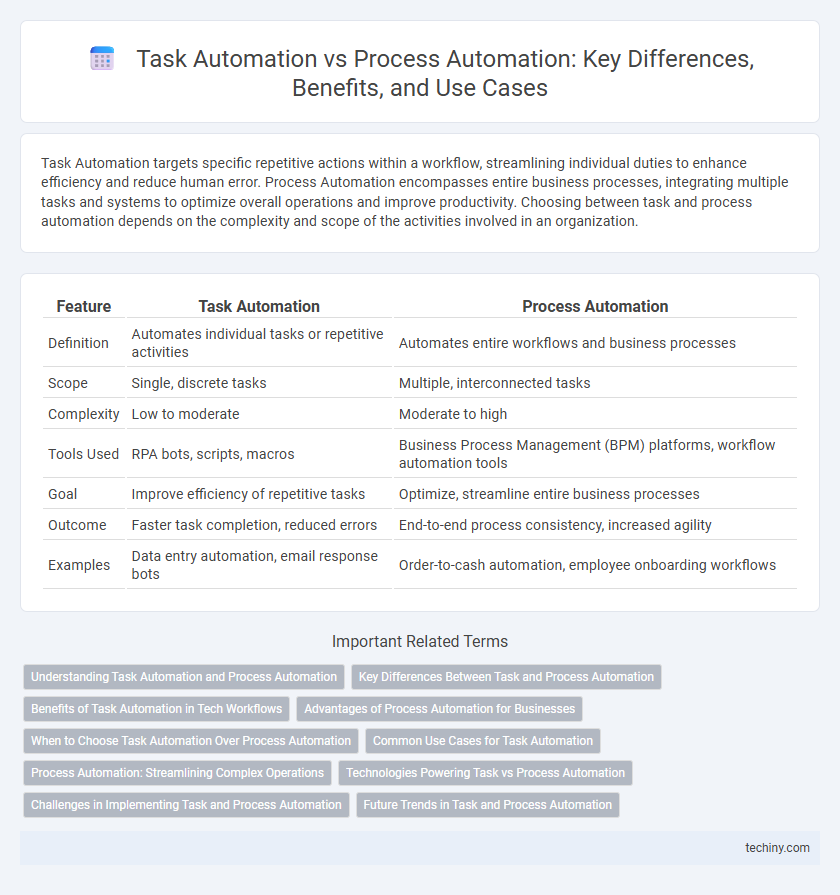Task Automation targets specific repetitive actions within a workflow, streamlining individual duties to enhance efficiency and reduce human error. Process Automation encompasses entire business processes, integrating multiple tasks and systems to optimize overall operations and improve productivity. Choosing between task and process automation depends on the complexity and scope of the activities involved in an organization.
Table of Comparison
| Feature | Task Automation | Process Automation |
|---|---|---|
| Definition | Automates individual tasks or repetitive activities | Automates entire workflows and business processes |
| Scope | Single, discrete tasks | Multiple, interconnected tasks |
| Complexity | Low to moderate | Moderate to high |
| Tools Used | RPA bots, scripts, macros | Business Process Management (BPM) platforms, workflow automation tools |
| Goal | Improve efficiency of repetitive tasks | Optimize, streamline entire business processes |
| Outcome | Faster task completion, reduced errors | End-to-end process consistency, increased agility |
| Examples | Data entry automation, email response bots | Order-to-cash automation, employee onboarding workflows |
Understanding Task Automation and Process Automation
Task automation involves automating specific, repetitive tasks such as data entry or email responses to increase individual efficiency. Process automation integrates multiple task automations into a cohesive workflow, streamlining entire business processes like order fulfillment or employee onboarding. Understanding the distinction between task automation and process automation is crucial for optimizing operational productivity and aligning automation strategies with organizational goals.
Key Differences Between Task and Process Automation
Task automation targets individual repetitive actions, such as data entry or email responses, using tools like robotic process automation (RPA). Process automation encompasses a broader workflow, integrating multiple tasks across systems to improve overall operational efficiency and includes technologies like BPM software. Key differences lie in scope, with task automation handling isolated actions and process automation managing end-to-end procedures involving multiple steps and stakeholders.
Benefits of Task Automation in Tech Workflows
Task automation streamlines repetitive tasks in tech workflows, significantly reducing manual errors and boosting productivity. By automating routine activities such as code testing, deployment, and data entry, teams can focus on higher-value strategic work. This targeted efficiency improvement accelerates project timelines and enhances overall operational agility.
Advantages of Process Automation for Businesses
Process automation streamlines complex workflows by integrating multiple tasks into a cohesive system, significantly enhancing operational efficiency and reducing human error. It enables real-time data analytics and monitoring, allowing businesses to optimize resource allocation and improve decision-making processes. By automating end-to-end processes, companies achieve scalable growth, higher productivity, and consistent compliance with industry regulations.
When to Choose Task Automation Over Process Automation
Task automation is ideal when focusing on repetitive, well-defined activities that require minimal decision-making, such as data entry or email routing. It streamlines individual tasks without altering the overarching workflow, maximizing efficiency for specific actions. Choosing task automation over process automation is optimal when the goal is to enhance speed and accuracy in discrete tasks rather than redesign entire business processes.
Common Use Cases for Task Automation
Task automation is commonly applied in repetitive, rule-based activities such as data entry, email filtering, and report generation, significantly reducing manual effort. It is ideal for individual tasks within workflows, like scheduling appointments or updating databases, enhancing accuracy and efficiency. Unlike process automation, which optimizes entire workflows, task automation targets specific, isolated tasks to streamline operations.
Process Automation: Streamlining Complex Operations
Process Automation streamlines complex operations by integrating multiple tasks into a cohesive workflow, enhancing efficiency and reducing errors. Unlike Task Automation, which targets individual repetitive activities, Process Automation optimizes end-to-end business functions involving multiple systems and teams. Leveraging technologies such as Robotic Process Automation (RPA) and Business Process Management (BPM) enables organizations to achieve greater scalability and improved operational agility.
Technologies Powering Task vs Process Automation
Task automation leverages technologies like robotic process automation (RPA), artificial intelligence (AI), and machine learning (ML) to handle repetitive and rule-based tasks with precision and speed. Process automation integrates advanced tools such as business process management (BPM) software, workflow automation platforms, and enterprise resource planning (ERP) systems to optimize and streamline entire business processes across multiple departments. The combination of these technologies enables organizations to boost efficiency, reduce errors, and scale operations effectively.
Challenges in Implementing Task and Process Automation
Challenges in implementing task automation often include integrating disparate software systems, managing data accuracy, and addressing employee resistance due to fears of job displacement. Process automation faces complexities in mapping end-to-end workflows, ensuring scalability across departments, and maintaining compliance with industry regulations. Both require robust change management strategies and continuous monitoring to adapt to evolving business needs and technology updates.
Future Trends in Task and Process Automation
Task automation is evolving with advancements in AI, enabling more intelligent and adaptive robots that perform specific repetitive tasks with higher precision and minimal human intervention. Process automation trends emphasize integrating robotic process automation (RPA) with artificial intelligence and machine learning to handle complex workflows, improve decision-making, and optimize end-to-end business processes. Future developments focus on hyperautomation, combining multiple automation tools and technologies to create seamless, scalable, and highly efficient automation ecosystems across industries.
Task Automation vs Process Automation Infographic

 techiny.com
techiny.com